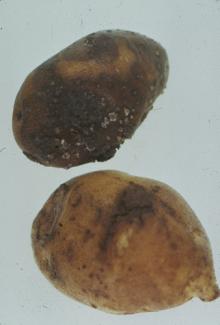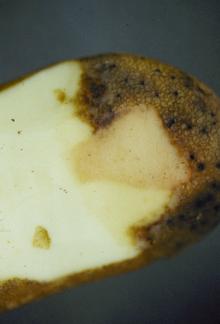By P. B. Hamm and C. M. Ocamb
Cause Phytophthora erythroseptica, a soilborne fungus-like organism. The disease is directly associated with high soil moisture. It becomes a problem in storage by encouraging the development and spread of soft rot. Pink rot does not spread in storage by spore movement but grows from tuber to tuber.
Symptoms Internal rotted tissue is a dirty, creamy white at first, appearing water soaked yet leathery; the texture has been described as like a cooked potato. On exposure to air, with time it turns pink, later becoming darker brown. There is a definite margin between rotted and healthy tissue. This organism does not cause a cavity like that of dry rot or symptoms like Pythium leak since this organism infects the whole tuber, out to the surface, as it grows through the tuber.
Cultural control
- Avoid excessive soil moisture, especially late in the season, and provide good drainage.
- Do not bring infected tubers into storage if possible. Remove wet tubers from storage.
When tubers are in storage, use high air flow initially to allow for healing and to remove excess moisture from the pile. Maintain appropriate air flow and humidity during storage so that infected tubers dry and do not cause additional damage in storage.
Chemical control One application when plants are flowering has been shown effective in Colorado. A second application two weeks following the first application has an increased benefit. New in-furrow application at planting reduces cost over two aerial applications. Resistance to mefenoxam (active ingredient in Ridomil Gold) is a significant problem to growers in regions where potato is cropped regularly.
- Orondis Gold (Group 49 + 4) at 27.8 fl oz/A as an in-furrow application at planting. Preharvest interval is 14 days. 48-hr reentry.
- Quadris Ridomil Gold (Group 11 + 4) at 0.82 fl oz/1,000 row feet applied in-furrow using 3 to 15 gal/A of water. See label for reentry intervals.
- Ranman (Group 21) at 0.42 fl oz/1,000 row feet in-furrow at planting or at 2.75 fl oz/A at hilling. In Idaho only (SLN ID-060011). Preharvest interval is 7 days. 12-hr reentry.
- Ridomil Gold Bravo SC (Group 4 + M5) at 2.5 pints/A following tuber initiation when the largest tubers are the size in diameter of a nickel. Make a second application 14 days later. Under severe pressure a third application may be made 14 days later. Do not use within 14 days of harvest. Ridomil resistance has been reported in Idaho. 48-hr reentry.
- Ridomil Gold SL (Group 4) at 1.0 to 2.0 pints/A as a broadcast or band treatment incorporated preplant or at planting. Make application directly over the seed piece(s) prior to row closure or use markout application method (incorporated). 48-hr reentry.
- Ridomil Gold MZ (Group 4 + M3) at 2.5 lb/A. One application when tubers are nickel-size (flowering). A second application two weeks following the first where pink rot pressure is high. Do not use within 14 days of harvest. Note: Contains an EBDC fungicide, so take care not to exceed seasonal limits. 48-hr reentry.
- Ridomil Gold Copper (Group 4 + M1) at 2 lb/A. One application when tubers are nickel-size (flowering). A second application two weeks following the first where pink rot pressure is high. Do not use within 14 days of harvest. Do not use with Polyram. 48-hr reentry.
- V-10208 (Group 22) at 8 fl oz/A in-furrow and then side-dressed after at least a 25-day interval. 12-hr reentry.
Biological control
- Amplitude ST at 3.2 to 4.8 fl oz/100 lb seed pieces, 6 to 8 fl oz per 1,000 ft row as an in-furrow treatment, or 3 to 4 quarts/A as a chemigation treatment on 14- to 21-day intervals. Preharvest interval is 0 days. 4-hr reentry. O
- Bexfond at 7 to 14 fl oz/A. 4-hr reentry. O
- Stargus at 6 to 8 fl oz per 1,000 ft row as an in-furrow treatment, 3 to 4 quarts/A as a soil drench on 10- to 14-day intervals, or 3 to 4 quarts/A as a chemigation drip treatment on 14- to 21-day intervals. Preharvest interval is 0 days. 4-hr reentry. O


